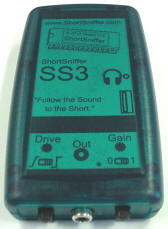

Typical scenario: The newly assembled prototype gizmo wouldn’t start up. It took a while, but you finally found the problem with your scope, after noticing some signals had compromised logic levels. The continuity beeper confirmed the diagnosis that D7 is shorted to D6, somewhere on the PC board. All you have to do is find where the short is located. It shouldn’t be too hard, since those two lines are only parallel for 15 inches, and only 4 of those inches are under chips or on inner layers . . . No problem . . . Now, where did you put that ShortSniffer? Click here to see the ShortSniffing troubleshooting process: |
The ShortSniffer LOCATES short circuits in electronics circuits, projects, and is specifically designed for working with fine-pitch surface mount PC boards.
The ShortSniffer injects an audio current into a conductive circuit, allowing the current Path to be followed with the non-contact inductive pick-up Probe. The basic short circuit locating principle can be reproduced with a signal generator, an inductive pick-up coil, an amplifier, and a speaker. The ShortSniffer SS3 has been designed for convenience and optimized for PC board short circuit locating performance.
The ShortSniffer is not a short circuit detector, but a short circuit locator. You’ll have to rely on your troubleshooting techniques to determine that you have a short circuit. You can check out the video presentation for some steps to determine which nets are shorted. Once you know which nets are shorted together, connect the ShortSniffer, and “follow the Sound to the Short”.
History:
- The original design was produced in the early 90s and has been used successfully ever since. I compliment myself for making it, every time I rapidly pinpoint a short. I have even fixed shorts on inner layers of PC boards, after first verifying the location to 1mm (radius), then drilling at that location. The newest design is the ShortSniffer SS3, which senses the direction of the current flow to help with some of the trickiest shorts. The inductive pick-up probe has an LED that lights to indicate direction, and the stereo headphone jack provides stereo imaging to indicate the injected test current flow direction. Together, with the increased gain and drive features, the SS3 is your best PC Board short circuit locating choice.
Operation:
General Information and Operating Instructions (PDF document)
Key Benefits
- locates PCB shorts under solder mask, under components
- locates PCB shorts on inner PCB layers
- non-contact (inductive) pickup wand
- pinpoint short to within 2mm radius
- rapid location with audio feedback
- no need for relative or reference measurements
- battery operated
- diode clamped current drive, won’t harm your circuitry
- edge-slope control to reduce effects of parallel capacitance paths
- stereo audio imaging to reduce confusion on complicated short circuit paths
- “Follow the Sound to the Short”
